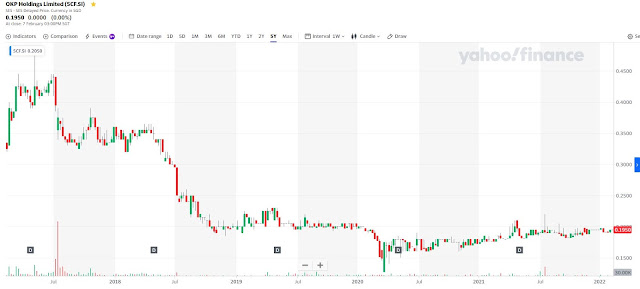Profit Alert for Centurion
Perhaps the one above had heard my desperation and decided to bestow some good news upon me.
Centurion had announced that there is a hefty profit alert.
"...the Group is expected to record a substantial increase in the net profit attributable to equity holders of the Company for FY2021 by not less than 200% as compared to a net profit attributable to equity holders of the Company of approximately S$17.2 million for the corresponding period in 2020"
At 33.5 cents a share, the current market capitalization stands at 281.6m. A 200% gain would put net profit at the 50m region, which will make the stock look cheap (at last?).
The announcement narrates the reasons for this improvement:
"(i) the expansion of the Group’s portfolio of purpose-built workers accommodation (“PBWA”) in Singapore and Malaysia since the fourth quarter of 2020; and
(ii) the steady recovery of occupancy of the Group’s purpose-built student accommodation (“PBSA”) assets in the United Kingdom reaching 82% for the second half of FY2021;
as well as due to a fair valuation loss of approximately S$3.1 million in FY2021 as compared to a fair valuation loss of approximately S$27.6 million in FY2020 in relation to the Group’s investment properties.
"
The expansion of PBWA is expected, and hopefully should be the main reason for improvement. The increased in PBSA is welcomed, but not expected to be the main contributor since it was not contributing significantly to the top line earlier. The fair valuation loss of 3.1m, improved from an earlier fair value loss of 27.6m in the previous year, means that:
If the profit was 17.2m last year, should we add 27.6m of valuation loss (since it is largely paper loss) back to the bottom line of 2020, it would mean that the net profit was 44.8m.
At an estimated 50m this year, the improvement is not much. Henceforth, I would pay attention to the numbers arising from the PBWA slice of the business. The recovery of the PBSA was always in the cards, it was just a matter of when.
Would Centurion choose to restart its dividend distribution this time?
Initial Capital Injection into Nanyang Holdings (HKEX: 212)
The history of Nanyang Holdings had an uncanny similarity to Berkshire Hathaway. In 2009, it made the painful decision to cease its textile operation, paying up to 40m to end construction of a factory. There were about 20 employees in 2009. Today, there are only 13.
Instead, they decide to turn their focus into property rental, converting the space of the space which the company held land use right of (in the form of joint ventures with their Chinese counterparts in mainland China), to office or factory rental. Their prized property is Nanyang Plaza in Hong Kong.
Throughout the decade, they invested and increase, through rights issues, in their shareholding in Shanghai Commercial and Savings Bank (SCSB). The major shareholder is also the chairman of this entity, and this shareholding is very likely extremely long term.
Lastly, the company has an investment portfolio that is growing, though insignificant when viewed against its total assets.
Layman Valuation
The sum it up:
As of 19-Feb-2022:
Market Capitalization: 1.35B HKD
Source: https://www.hkex.com.hk/Market-Data/Securities-Prices/Equities/Equities-Quote?sym=212&sc_lang=en
1) Investment Portfolio: Fair value of 456m HKD.
"Equities comprised approximately 80.2%
(of which U.S. 41%; European 14%; Japanese 5%; Asia ex-Japan 27% and Emerging Markets 13%),
bonds 11.8% (of which U.S. 85%; European 3%; Emerging Markets 5%
and others 7%), commodities 2.2% and cash 5.8%."
2) Investment in SCSB: 2.2B HKD
3) Nanyang Plaza: 2.47B (based on level 3 valuation, hence least reliable)
4) Total Liabilities: 104.7m
After some pretty liberal discounting:
The Net Asset Value of 3.3B implies at significant 240% margin of safety after very conservative discounting. In case you ask, I discounted the valuation of Nanyang Plaza heavily, because the cap rate is on the low side of 3.x% currently.Risks
The share buy backs signifies shareholder alignment, which is great. But what are the downsides?
-inability to continue joint ventures with the Chinese partners due to conflict, regulation (unable to renew land use rights, regulation, etc)
-Significant losses from the investment portfolio due to active management. The company makes decision on its portfolio based on macro and economic trends, far too sophisticated for a value simpleton like myself. There will bound be times where they will trip badly. However, the value of the investment portfolio is not a huge concern as the following, which is...
-Political issues between Taiwan and Mainland China, as SCSB is mainly running its business in Taiwan. SCSB does have stake in SCB (Shanghai Commerical Banks) which has branches in Hong Kong and China.
-Liquidity is on the low side. Hence, do not over allocate too much of your portfolio into such stocks. In the event that you need cash, this would be a burden.
As the value is apparent, I have started injecting capital into this company. 4.25% of my portfolio is vested, and there are currently 12 companies vested, with the top 5 holdings representing 73.08%. I plan to accumulate heavily into this stock.











